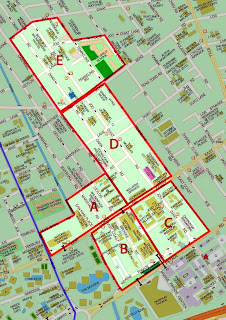
Site Information
Located by the sea, land was reclaimed all the way to East Coast Park to provide more land for housing and recreational purposes due to shortage of land in the late 1960s after Singapore gained independence.
Katong was the location of many villas and mansions of the wealthy elite in the late 19th to the mid 20th centuries, who made their fortunes in the Far East and built seaside resorts, villas and manors along the beachfront of Katong, beginning from Katong Park to the end of the East Coast.
Katong's rich cultural mix has contributed to its unique cuisine. Katong is well known for its restaurants serving Peranakan (Straits Chinese) cuisine, particularly a spicy Malay noodle soup called Peranakan laksa. Katong Laksa originated from Joo Chiat area. The hawker was nicknamed 'Jangok" by the peranakan, because he had a few strands of hair at his chin. He was an itinerant hawker and lived in Tembling Road/Joo Chiat Terrace. Later he moved his business into the eating house at East Coast Road/Ceylon Road. Because the Katong people loved his laksa, it has come to be known as the Katong laksa throughout the world in Hong Kong and New York.
Etymology
Katong is the name of an exotic species of sea turtle now extinct. It also means the rippling effect of a sea mirage when looking at a shoreline. Tanjong Katong was a popular beach along the East Coast. Tanjong means cape in Malay. This coastal feature was located near the present Tanjong Katong Flyover across East Coast Parkway and had since disappeared due to land reclamation.
History
Katong's history has been rooted in prestige and wealth. Many wealthy English, Portuguese, Anglo-French and Chinese settlers bought parcels of land here beside the sea to cultivate plantations. They built business empires from trading in these early international commodities such as cotton, coconut and gambier. The earliest cultivation took place in 1823, when Francis Bernard, son-in-law of Lieutenant Colonel William Farquhar, the first Resident of Singapore, started a coconut estate in the district.
Gradually, the crown of Singapore sold plots of land in the area stretching from Frankel Avenue, Siglap Road, to the Geylang River. From Geylang Road to the sea, land was granted to individuals in large parcels, ranging from 8 to 200 hectares. Pioneer estate owners included Thomas Dunman, Thomas Crane, Sir Jose d'Almeida, John Armstrong, Whampoa Hoo Ah Kay, Chew Joo Chiat and the Little family.
Most of the land was given over to coconut plantations because of the suitably sandy conditions, although cotton was also introduced in February 1836 . Unnfortunately, cotton planting was largely a failure and only coconut plantations remained.
In the first three decades of the twentieth century and especially after World War I, Katong developed from a weekend seaside retreat into a home for the wealthy, who built their main residence away from the hustle and bustle of town-life in the form of ornate and immense colonial seaside bungalows. Katong then took the form of a wealthy suburb. Large colonial, Chinese and Peranakan bungalows were built along Meyer Road and Mountbatten Road from Katong Park to Tanjong Katong (which in English means "Road of the Turtle Mirage Promontory"). By 1928 Katong had grown to the extend that the Inspector-General of Police, H.Fairburn remarked: "The development of the area from Katong to Joo Chiat, which has been so rapid in the past two years, promises to continue, and from every point of view one sees the necessity of providing for a sub-divisional station in the suburb. The suburb at present possess no police station." From then on Katong encroached into Joo Chiat area from Tanjong Katong to Telok Kurau Road. East Coast Road (now divided into East Coast Road and Upper East Coast Road) have many upper-class family homes.
The Katong of today covers both sides of Tanjong Katong Road and the seaward strip along Mountbatten Road and East Coast Road, stretching from Katong Park up to Martia Road. Also included in this strip are the Katong Church and CHIJ Katong Convent. The present Katong area stretches from Mounbatten Road, East Coast Road to Siglap. The Katong in Joo Chiat was formally an ethnic enclave of the Eurasians.
Many "town" Eurasians moved here in the 1920s and 1930s due to several reasons. They were attracted by the building of Saint Patrick's (1933) and also by the Holy Family Church also known as "Katong Church". Convent of the Holy Infant Jesus in Katong (CHIJ Katong) was built much later on Martia Road and expanded its secondary school into Marine Parade after land reclamation of the East Coast in 1965. The Eurasians wanted better homes after the Depression; however, the city centre of Singapore and its surrounding area was experiencing congestion and pollution with overcrowding being common. Therefore, they sold their estates in town and built their homes in Katong. The Chinese settlers followed suit.
Highlights
The area is traditionally associated with the Eurasian and Peranakan community. However, many high-rise apartment blocks now stand alongside the traditional shophouses and Peranakan terrace houses. In 1993, the Joo Chiat neighbourhood which comprises the historical centre of Katong, with its delicate and uniquely Singaporean architecture mixing Chinese, Peranakan and English colonial styles, was designated a national heritage conservation area by the Singapore Government. Many of the traditional houses in the area, which includes the ancient villa of Chinese tycoon Joo Chiat, have been conserved and are now luxury homes for the wealthy elite from throughout the world.
From Wikipedia, the free encyclopedia






0 Response to "DMP 2010: Katong/Joochiat Site Background"